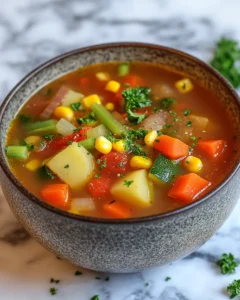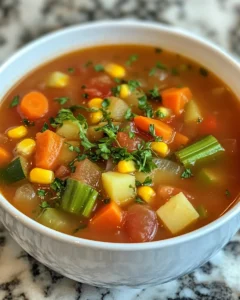There’s something timeless about a big pot of soup simmering away in the kitchen. On a cool autumn afternoon, a rainy spring day, or even as a light yet nourishing meal on a summer evening, soup has a way of bringing comfort and connection to the table. One of the most beloved and versatile variations is the Classic Vegetable Medley Soup—a recipe that celebrates the natural goodness of fresh vegetables while offering endless room for customization.
The inspiration for this dish comes from the tradition of resourceful home cooking. For generations, families around the world have transformed whatever vegetables were in season into hearty, satisfying soups. This recipe reflects that spirit: simple, wholesome, and deeply nourishing. Whether you’re feeding a busy family, looking for a meal-prep staple, or just craving a bowl of warmth, this soup is a reminder that good food doesn’t need to be complicated—it just needs to be made with care.
Why You’ll Love This Classic Vegetable Medley Soup
When it comes to soups, this recipe checks all the boxes. It’s easy, budget-friendly, customizable, and packed with flavor. But beyond its simplicity, there are plenty of reasons why this soup will become a household favorite:
-
Nutrient-packed: With a variety of vegetables, this soup delivers vitamins, minerals, and fiber in every bite.
-
Perfect for all seasons: Serve it piping hot in the winter or slightly chilled during warmer months.
-
Family-friendly: Even picky eaters can’t resist the comforting flavors.
-
Meal-prep friendly: Make a large batch and store it for quick lunches or dinners throughout the week.
-
Diet-friendly: Naturally vegetarian, with options to make it vegan, gluten-free, or protein-packed.
This soup isn’t just food—it’s a wholesome, feel-good experience that nourishes both the body and the soul.
Ingredients
Here’s what you’ll need to make a satisfying pot of Classic Vegetable Medley Soup. The best part? You can adjust the list depending on what’s in your pantry or what’s in season.
-
2 tablespoons olive oil
-
1 medium onion, diced
-
2 cloves garlic, minced
-
2 medium carrots, sliced
-
2 celery stalks, sliced
-
1 medium zucchini, diced
-
1 cup green beans, trimmed and cut into bite-sized pieces
-
1 medium potato, peeled and cubed
-
1 red bell pepper, diced
-
1 cup corn kernels (fresh, frozen, or canned)
-
1 cup peas (fresh or frozen)
-
1 can (14.5 oz) diced tomatoes
-
6 cups vegetable broth
-
1 teaspoon dried thyme
-
1 teaspoon dried basil
-
1 bay leaf
-
Salt and black pepper to taste
-
Fresh parsley, chopped (for garnish)
Optional add-ins for variety:
-
Spinach or kale leaves for extra greens
-
Cooked beans or lentils for added protein
-
Small pasta or rice for a heartier version
Directions
Follow these step-by-step instructions for a flavorful, hearty soup that’s sure to impress. Each stage is designed to maximize flavor while keeping the process approachable for any home cook.
Sauté the Aromatics
The very first step in building any great soup is creating a strong flavor base. In this recipe, that begins with sautéing aromatics. Heat two tablespoons of olive oil in a large, heavy-bottomed pot over medium heat. Once the oil shimmers, add the diced onion, garlic, carrots, and celery.
Cook these ingredients together for about 5 minutes, stirring occasionally to prevent burning. The onion should become soft and translucent while the garlic releases its rich aroma. The carrots and celery, often called mirepoix when paired with onion, form a classic foundation for countless soups and stews. This stage is more than just softening vegetables—it’s about unlocking layers of flavor that will carry through the entire dish.
For even more depth, allow the onions to take on the slightest golden color. That caramelization adds a natural sweetness, perfectly balancing the earthiness of the other vegetables.
Add the Heartier Vegetables
Once your base is fragrant and softened, it’s time to add the heartier vegetables. These are the ones that need a little more cooking time to become tender. Stir in the potato cubes, zucchini, trimmed green beans, and diced red bell pepper.
Let them cook for another 3–4 minutes, gently stirring so every piece gets coated in that aromatic mixture you just created. This step allows the vegetables to start absorbing flavor before the broth is introduced. The potatoes will soak up the garlic and onion, while the bell pepper adds a subtle sweetness that enhances the overall balance of the soup.
Think of this stage as “marrying the flavors.” By layering the vegetables gradually, you prevent them from tasting one-dimensional. Each bite of soup later will be filled with complexity because you took the time to build it step by step.
Incorporate the Tomatoes and Seasoning
Now it’s time to add brightness and depth. Pour in the can of diced tomatoes along with their juices. Tomatoes are a wonderful addition to vegetable soup because they bring natural acidity, balancing the richness of starchy vegetables like potatoes.
At this point, stir in the dried thyme, basil, and the bay leaf. Sprinkle in a pinch of salt and black pepper as well. As the mixture simmers, these herbs begin to bloom, infusing the broth with their earthy and slightly sweet notes.
This stage is when your kitchen truly starts to smell like comfort food. The herbs meld with the tomato juices, creating a savory aroma that signals the soup is well on its way to becoming something special.
Pour in the Broth
With the base vegetables and seasonings in place, it’s time to add the liquid that ties everything together. Pour in six cups of vegetable broth. Give the mixture a stir, scraping up any bits from the bottom of the pot—that’s pure flavor you don’t want to lose.
Raise the heat until the soup reaches a gentle boil. Once it bubbles, immediately reduce it to a simmer. Cover the pot and let it cook for 20–25 minutes. This slow simmering allows the potatoes to become tender while the other vegetables release their natural juices into the broth.
Patience is key here. Rushing this step could leave your vegetables undercooked or the flavors underdeveloped. Instead, let the pot quietly do its work, transforming humble ingredients into a wholesome medley.
Add the Quick-Cooking Vegetables
After the simmering time, most of your soup is nearly complete. But now comes the final burst of freshness—adding quick-cooking vegetables like peas, corn, and optional leafy greens such as spinach or kale.
These ingredients don’t need long to cook. Just 5–7 minutes is enough for the peas and corn to warm through and for greens to wilt into tender ribbons. By adding them at the end rather than the beginning, you preserve their color, texture, and nutrients.
This step gives the soup vibrancy and ensures each spoonful feels lively and fresh. Imagine bright green peas and golden corn kernels standing out against the deep red tomato broth—it’s as beautiful as it is delicious.
Taste and Adjust
Before serving, it’s crucial to taste your soup. Remove the bay leaf, then grab a spoon and check the seasoning. Does it need more salt? A touch of pepper? Perhaps a squeeze of lemon juice for brightness?
This step is where you make the recipe your own. Some people prefer their soup slightly spicier and may add a pinch of red pepper flakes. Others might like a hint of freshness from extra herbs like parsley or dill. Adjusting at the end ensures that every flavor is balanced and nothing feels flat.
Serve and Garnish
Now comes the best part—serving. Ladle the hot soup into bowls, making sure each serving has a generous mix of vegetables and broth. Garnish with freshly chopped parsley for color and freshness.
This soup pairs beautifully with crusty bread, buttery crackers, or even a crisp side salad. The combination of hearty vegetables and savory broth makes it versatile enough to stand alone as a full meal or work as a starter before a larger spread.
Every spoonful delivers warmth, nutrition, and comfort. It’s not just soup—it’s a reminder of how simple ingredients, when treated with care, can turn into something extraordinary.
Tips for Making the Best Vegetable Soup
-
Cut vegetables evenly: This ensures even cooking and creates a visually appealing medley in every spoonful.
-
Build flavor gradually: Sautéing onions, garlic, carrots, and celery first creates a flavorful base. Don’t skip this step!
-
Choose fresh broth: The quality of your broth will directly affect the soup’s flavor. Use homemade or high-quality store-bought broth for the best results.
-
Don’t overcook: Vegetables should be tender but not mushy. Keep an eye on the pot as it simmers.
-
Experiment with herbs: While thyme and basil work beautifully, you can also try oregano, rosemary, or even fresh dill.
Variations to Try
One of the joys of a classic vegetable soup is its adaptability. Here are a few creative variations to inspire you:
-
Mediterranean Twist: Add chickpeas, olives, and a sprinkle of feta cheese.
-
Hearty Grain Boost: Stir in cooked quinoa, barley, or farro for added texture and nutrition.
-
Spicy Kick: Add a pinch of red pepper flakes or diced jalapeños for some heat.
-
Creamy Comfort: Blend half the soup with an immersion blender and mix it back in for a creamy consistency without dairy.
-
Protein Power: Add cooked chicken, turkey, or tofu to make it a more filling main dish.
What to Serve with Classic Vegetable Medley Soup
This soup is versatile enough to be a standalone meal or the star of a complete spread. Pair it with:
-
Freshly baked bread like sourdough, baguettes, or cornbread.
-
Simple green salads for a refreshing balance.
-
Grilled cheese sandwiches for a nostalgic and comforting duo.
-
Roasted vegetables to double up on the veggie goodness.
-
Savory muffins like cheddar and herb muffins for a filling side.
Storage and Meal Prep Tips
One of the best things about this recipe is how well it keeps.
-
Refrigeration: Store cooled soup in an airtight container in the fridge for up to 5 days.
-
Freezing: Freeze in freezer-safe containers or bags for up to 3 months. Thaw overnight in the fridge before reheating.
-
Reheating: Warm on the stovetop over medium heat or in the microwave in short intervals, stirring occasionally.
Pro tip: If you’re making soup with pasta or rice, store them separately and add them to the soup when serving. This prevents them from soaking up all the broth.
Health Benefits of Vegetable Medley Soup
This soup isn’t just tasty—it’s also a powerhouse of nutrition.
-
Rich in fiber: Supports digestion and promotes satiety.
-
High in antioxidants: Tomatoes, bell peppers, and leafy greens help fight free radicals.
-
Low in calories: A guilt-free choice that’s perfect for weight management.
-
Supports immunity: Garlic, carrots, and leafy greens contribute to a strong immune system.
-
Heart-healthy: Olive oil and vegetables provide essential nutrients for cardiovascular health.
Frequently Asked Questions
Can I make this soup in a slow cooker?
Yes! Simply add all the ingredients to your slow cooker, except peas and corn. Cook on low for 6–7 hours or high for 3–4 hours, then stir in peas and corn during the last 30 minutes.
Can I blend this soup?
Absolutely. Use an immersion blender for a partially creamy soup, or blend it completely for a smooth consistency.
What if I don’t have all the vegetables listed?
No problem! This recipe is flexible—use whatever vegetables you have on hand.
Can I make it ahead of time?
Yes. The flavors actually deepen after sitting for a day, making it even tastier as leftovers.

Classic Vegetable Medley Soup Recipe
- Total Time: 55 minutes
- Yield: 6 servings 1x
Description
There’s nothing more comforting than a steaming bowl of vegetable soup made from simple, wholesome ingredients. This classic vegetable medley soup brings together a variety of fresh vegetables simmered in a flavorful broth, creating a nourishing dish that’s perfect for any season. Whether you’re looking for a cozy weeknight dinner or a healthy meal-prep option, this soup delivers warmth, nutrition, and comfort in every spoonful.
Ingredients
-
2 tablespoons olive oil
-
1 medium onion, diced
-
2 cloves garlic, minced
-
2 medium carrots, sliced
-
2 celery stalks, sliced
-
1 medium zucchini, diced
-
1 cup green beans, trimmed and cut into bite-sized pieces
-
1 medium potato, peeled and cubed
-
1 red bell pepper, diced
-
1 cup corn kernels (fresh, frozen, or canned)
-
1 cup peas (fresh or frozen)
-
1 can (14.5 oz) diced tomatoes
-
6 cups vegetable broth
-
1 teaspoon dried thyme
-
1 teaspoon dried basil
-
1 bay leaf
-
Salt and black pepper to taste
-
Fresh parsley, chopped (for garnish)
Instructions
-
Heat olive oil in a large pot over medium heat. Add onion, garlic, carrots, and celery. Cook for 5 minutes until softened and aromatic.
-
Stir in potato, zucchini, green beans, and bell pepper. Cook for 3–4 minutes to allow the vegetables to absorb flavor.
-
Add diced tomatoes with their juices, along with thyme, basil, bay leaf, salt, and black pepper. Stir well.
-
Pour in vegetable broth and bring to a gentle boil. Reduce heat to a simmer, cover, and cook for 20–25 minutes until potatoes are tender.
-
Add corn, peas, and any optional greens such as spinach or kale. Simmer for 5–7 minutes until peas and corn are heated through and greens have wilted.
-
Remove bay leaf, taste the soup, and adjust seasoning with extra salt, pepper, or a squeeze of lemon juice if desired.
-
Ladle soup into bowls, garnish with parsley, and serve with crusty bread or crackers.
Notes
-
For extra flavor, roast some vegetables before adding them to the soup.
-
If adding pasta or rice, cook separately and add when serving to avoid soaking up too much broth.
-
Soup tastes even better the next day as the flavors deepen.
-
Store leftovers in the fridge for up to 5 days or freeze for up to 3 months.
- Prep Time: 20 minutes
- Cook Time: 35 minutes








